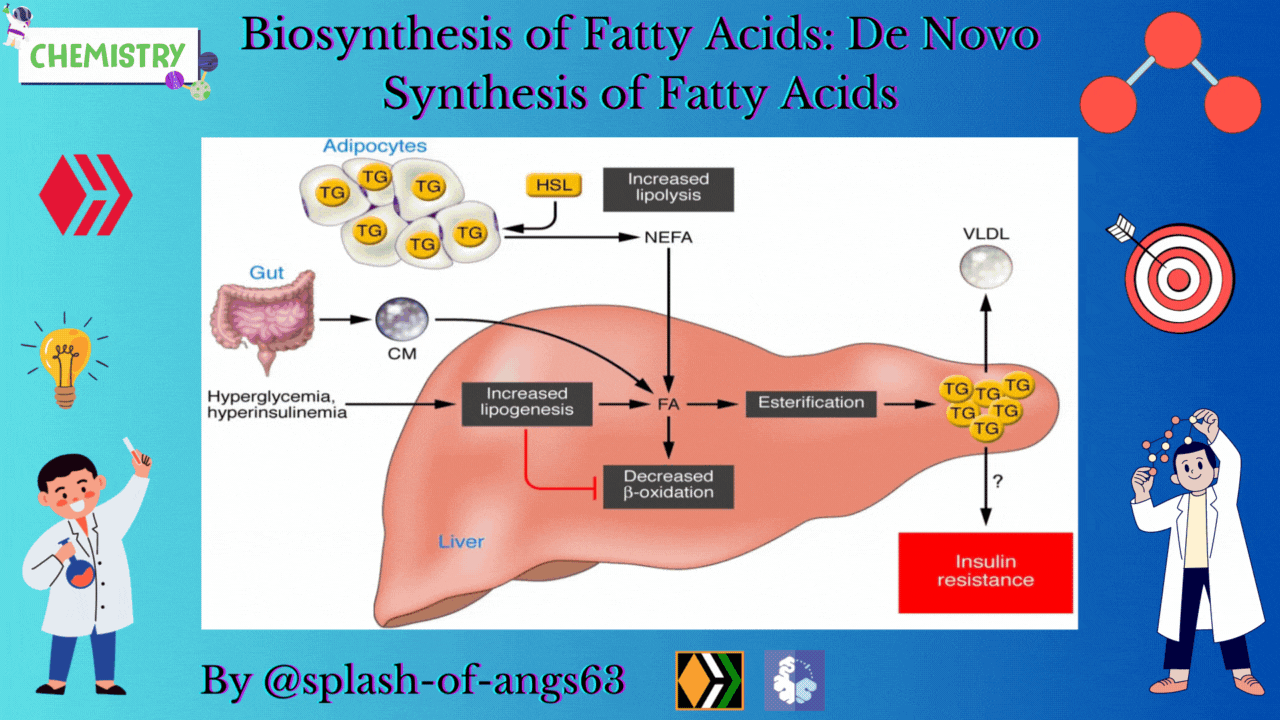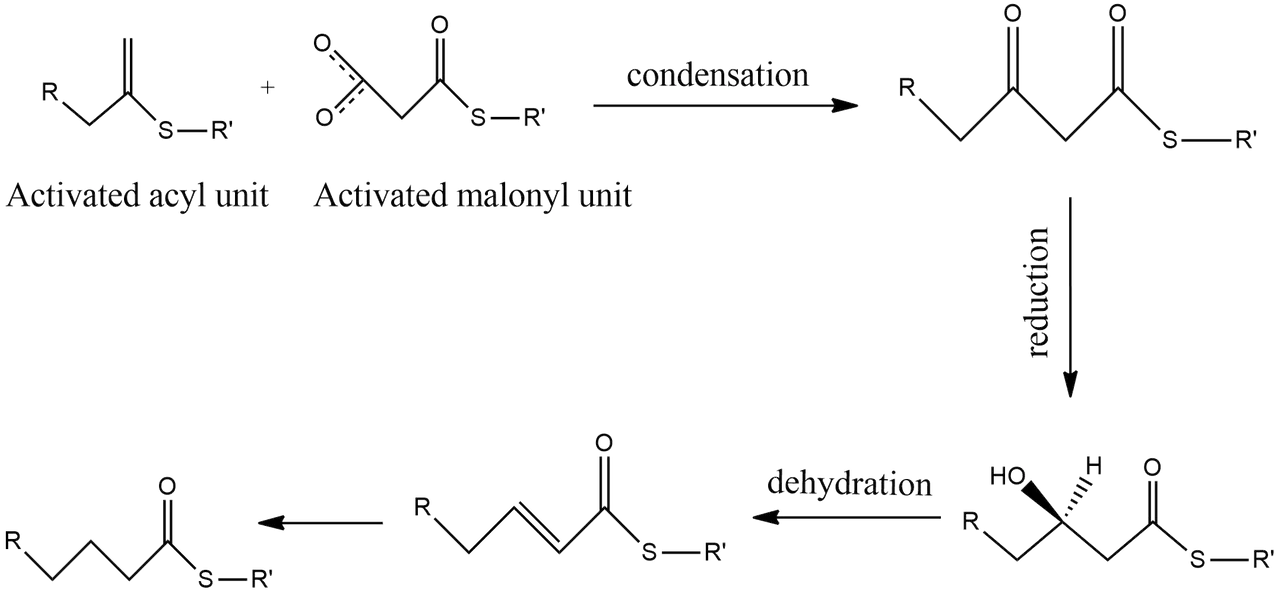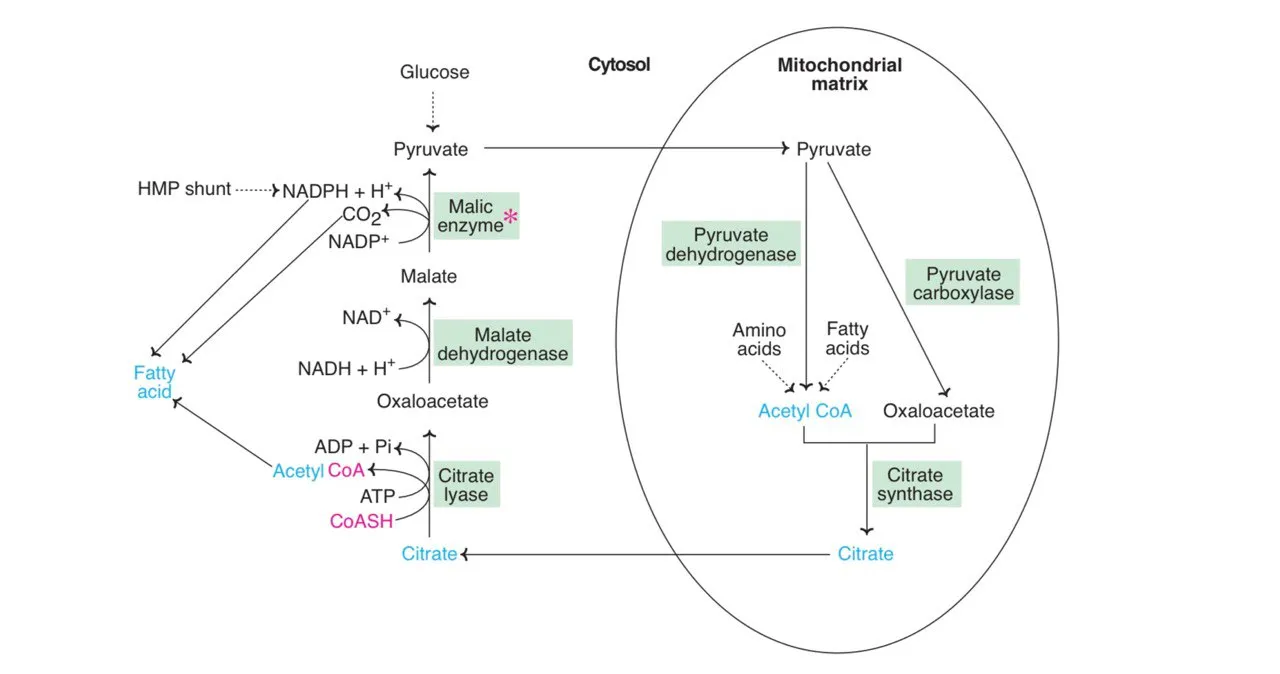Greetings to everyone! Today we shall be discussing a topic from the bioorganic chemistry or could also say that from biomolecular chemistry i.e., the biosynthesis of fatty acids. We shall stick to the De Novo synthesis of fatty acids in this post.
Fatty acids are made up of a long hydrocarbon chain which is hydrophobic in nature and a carboxylate group which is hydrophilic in nature. They have various roles and functions in our body but they are mostly used as fuel to perform various metabolic reactions. They are also used to build cell membrane i.e., phospholipid and glycolipids. Fatty acids are used to diversify protein functionality and are also used to build hormones and other messenger molecules.

Fatty Acids Metabolism (FAM)
The FAM consist of a breakdown process and a synthesis process.

This is an oxidative process that releases an activated acetyl coenzyme-A unit, thereby shortening the hydrocarbon chain. by 2 carbon atoms. The activated Co-A units can enter the citric acid cycle, which can ultimately be used to form ATP molecules.
Synthesis Process
This is an reductive process that builds up the hydrocarbon chain of fatty acids. This proceeds with condensation of an activated acyl unit with malonyl unit.

De Novo Synthesis of Fatty Acids
The major portion of the fatty acids used by the body comes from the diet. Excess protein and carbohydrates can be converted to fatty acids and stored as triglycerides. The De novo (new) synthesis of fatty acids occurs mostly in liver, kidneys, adipose tissues and lactating mammary glands. This synthesis happens in cytosol and carbon atoms are incorporated into the growing carbon chain of the fatty acids from acetyl coenzyme-A (Co-A) using ATP and nicotinamide adenine dinucleotide phosphate (NADPH).
The enzyme machinery for fatty acid production is located in the cytosomal fraction of the cell. Acetyl CoA is the source of carbon atoms while NADPH provides the reducing equivalents and ATP supplies energy for fatty acids formation. The fatty acids synthesis may be learnt in 3 stages.

(1) Production of Acetyl CoA and NADPH
Acetyl CoA and NADPH are prerequisites for fatty acid synthesis. The first step in the De novo fatty acid synthesis is the transfer of acetate unit from acetyl CoA present in mitochondria to cytosol. Acetyl CoA present in mitochondria is produced by the oxidation of pyruvate and by the catabolism of certain amino acids. The CoA portion of acetyl CoA can not cross the inner mitochondrial membrane and only the acetyl portion enters the cytosol.
Acetyl CoA condenses with oxaloacetate in mitochondria to form citrate. Citrate is freely transported to cytosol where it is cleaved by citrate lyase to liberate acetyl CoA and oxaloacetate. Oxaloacetate in the cytosol is converted to malate.
Mallic enzyme converts malate to pyruvate. NADPH and CO2 are generated in this reaction. Both of them are utilized for fatty acids synthesis.
Advantages of coupled transport of acetyl CoA and NADPH:
The transport of acetyl CoA from mitochondria to cytosol is coupled with the cytosomal production of NADPH and CO2 which is highly advantageous to the cell for optimum synthesis of fatty acids.

(2) Carboxylation of acetyl CoA to Malonyl CoA
The carboxylation of acetyl CoA to form malonyl CoA is catalysed by acetyl CoA carboxylase (ACC) and requires ATP and CO2. This is thus an ATP dependent reaction and requires vitamin biotin for CO2 fixation. The vitamin biotin is covalently bonded to the lysyl residue of the carboxylase. The mechanism of action of acetyl CoA is similar to that of pyruvate carboxylase. Acetyl CoA carboxylase is a regulatory enzyme in fatty acid synthesis.
(3) Synthesis of fatty acids by the formation of acyl carrier protein derivatives
The remaining reactions of fatty acid synthgesis are catalysed by a multifunctional enzyme known as fatty acid synthase (FAS) complex. In eukaryotic cells, including man, the fatty acid synthase exists as a dimer with two identical units. Each monomer possesses the activities of seven different enzymes and an acyl carrier protein (ACP) bound to 4'-phosphapanetheine. Fatty acid synthase function as a single unit catalysing all the seven reactions. Dissociation of the synthase complex results in loss of of the enzyme activities. In the lower organisms i.e., prokaryotes, the fatty acid synthesis is carried out by a multienzyme complex in association with a separate acyl carrier protein. This is in contrast to eukaryotes where ACP is a part of fatty acid synthase.
Regulation of Fatty Acid Synthesis
fatty acid production is controlled by enzymes, metabolites, end products, hormones and dietary manipulations. Some of the important regulatory mechanisms are discussed hereunder.
Acetyl CoA carboxylase:
This enzyme controls a committed step in fatty acid synthesis. Acetyl CoA carboxylase exists as an inactive polymer (monomer) or an active polymer. Citrate promotes polymer formation, hence increases fatty acid synthesis. On the other hand, palmitoyl CoA and malonyl CoA causes depolymerization of the enzyme and therefore inhibits fatty acid synthesis.
Hormonal influence
Hormones regulate acetyl CoA carboxylase by a separate mechanism- phosphorylation (inactive form) and dephosphorylation (active form) of the enzyme. Glucagon, epinephrine and nor epinephrine inactivate the enzyme by cAMP- dependent phosphorylation. Insulin on the other hand dephosphorylates and activates the enzyme. Thus insulin promotes fatty acid synthesis while glucagon inhibits.
Dietary regulations
Consumption of high carbohydrates or fat-free diet increases the synthesis of acetyl CoA carboxylase and fatty acid synthase, which promotes fatty acid formation. On the contrary, fasting or high fat diet decreases fatty acid production by reducing the synthesis of these two enzymes.
Availability of NADPH
The reducing equivalent for fatty acid synthesis are provided by NADPH which come either from citrate (acetyl CoA) transport or hexose monophosphate shunt. About 50-60% of required NADPH is obtained from HMP shunt which is significantly influences fatty acid synthesis.
Well, this is all about the biosynthesis of fatty acid and the De novo synthesis of fatty acids. We shall meet again with an another post. Happy learning!
Biochemistry by U. Satyanarayana
Fatty acids synthesis: steps and significance
Hapticity and The Eighteen Electron Rule |ChemFam #36|
An Introduction To Organometallic Chemistry |ChemFam #35|
Applications of Zeolites: The 3D Molecular Sieves |ChemFam #34|
Properties of Zeolites: The 3D Molecular Sieves |ChemFam #33|
Zeolites: The 3D Molecular Sieves |ChemFam #32|
The Beauty of Eucalyptus Tree |ChemFam #31|
The Accidental Cure for Cancer: Cisplatin |ChemFam #29|
Acceptorless Dehydrogenation and Related Transformations |ChemFam #28|
Thermophysical Properties of Natural Gas-I |ChemFam #27|
PS The thumbnail image is being created by me using canva.com by taking template image from JCI


